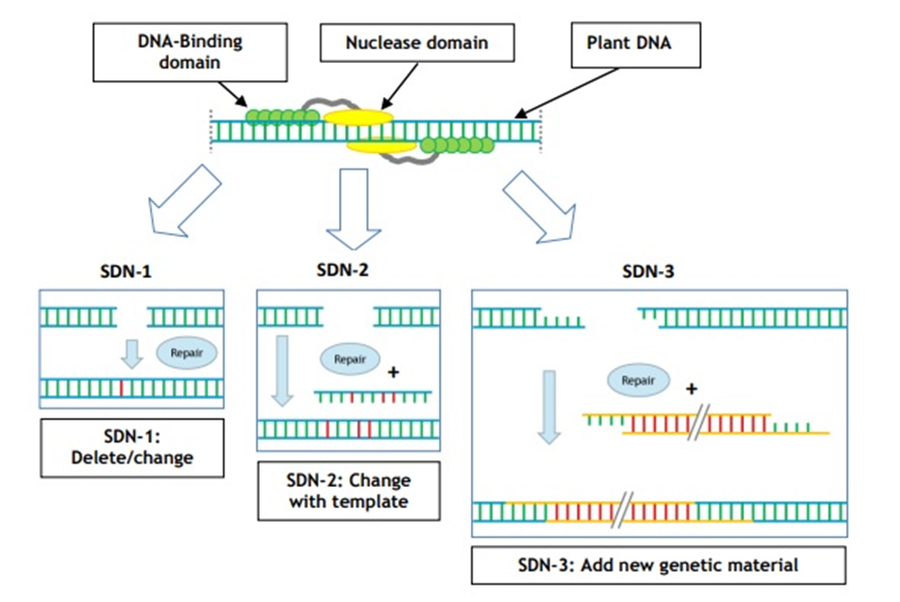- Home
- Prelims
- Mains
- Current Affairs
- Study Materials
- Test Series
Genome editing and Genetically modified organisms
The central government has paved the way for easy introduction of genome edited crops. The government has clearly distinguished such crops from genetically modified crops and has prescribed relatively easier norms for their introduction. The change in rules will allow genome-edited plants, or organisms without any “foreign” genes to be subjected to a different regulatory process than the one applied to those genetically engineered products with "foreign” genes.
Genome editing
- Genome is the complete genetic information of an organism and genome editing is a type of genetic engineering in which DNA is inserted, deleted, modified or replaced in the genome of a living organism.
- Genome editing targets the insertions to site specific locations.
Genome editing in agriculture:
- In the field of genome engineering, “CRISPR” or “CRISPR-Cas9” is used as a tool to target specific stretches of genetic code and to edit DNA at precise locations.
- Using this tool, genome editing can be used to insert specific traits in the gene sequence.
- The agriculture scientists has used this genome editing tool to bring the desired changes in the genome by using site directed nuclease (SDN) or sequence specific nuclease (SSN). Nuclease is an enzyme which cleaves through nucleic acid.
Categories
- Depending on the nature of the edit that is carried out using site directed nuclease (SDN), the process is divided into three categories:
- SDN1: It introduces changes in the host genome’s DNA through small insertions/deletions without introduction of foreign genetic material.
- SDN 2: It produces a double-stranded break, and the break is repaired by the cell where a small nucleotide template is supplied that is complementary to the area of the break, which is used by the cell to repair the break.
- SDN3: It induces a double-stranded break in the DNA, but is accompanied by a template containing a gene or other sequence of genetic material. The cell’s natural repair process then utilizes this template to repair the break; resulting in the introduction of the genetic material. This process involves larger DNA elements or full length genes of foreign origin which makes it similar to genetically modified organisms (GMO) development.

- Both SDN1 and SDN2, does not involve alien genetic material and the end result is indistinguishable from conventionally bred crop varieties.
Genome editing and Genetically modified organisms
- Genetically modified organisms(GMO) involve modification of the genetic material of the host by introduction of a foreign genetic material.
- In the case of agriculture, soil bacteria is the best mining source for such genes which are then inserted into the host genome using genetic engineering.
- For example, in case of cotton, introduction of genes cry1Ac and cry2Ab mined from the soil bacterium Bacillus Thuringiensis (BT) allow the native cotton plant to generate endotoxins to fight pink bollworm naturally.
- BT Cotton uses this advantage to help farmers naturally fight pink bollworm which is the most common pest for cotton farmers.
- The basic difference between genome editing and genetic modification in this context is that while the former does not involve the introduction of foreign genetic material, the latter does.
- In the case of agriculture, both the techniques aim to generate variants which are better yielding and more resistant to biotic and abiotic stress.
Need to distinguish the crops:
- Scientists both in India and across the world have drawn the line between Genetically Modified (GM) crops and genome edited crops.
- The latter has no foreign genetic material in them which makes them indistinguishable from traditional hybrids.
- So, the Environment Ministry has exempted genome edited crops through SDN 1 and SDN 2 process from stringent regulatory processes that are applied for GM crops.
- For SDN1 and SDN2 processes, the government will instead rely on reports of Institutional Biosafety Committee to exclude exogenous genetic material.
- The institutional biosafety committees are expert committees to deal with research and release of GM material. Such committees would now be entrusted to certify that the genome edited crop is devoid of any foreign DNA.
- This will allow such genome-edited plants without the need for GMO regulation at the Genetic Engineering Appraisal Committee (GEAC).
- This would be a less cumbersome and time consuming process for commercial release of such genome edited crops.
Institutional Biosafety Committee
- In India, the manufacture, import, research and release of Genetically Engineered Organisms (GEOs), as well as products made by the use of such organisms are governed by ''The Rules for Manufacture, Use, Import, Export and Storage of Hazardous Micro-Organisms, Genetically Engineered Organisms or Cells, (commonly referred to as “Rules 1989”)'' notified by the Ministry of Environment, Forest and Climate Change (MoEF&CC) under the Environment (Protection) Act 1986.
- According to these rules, the Institutional Biosafety Committee (IBSC) shall be constituted by all institutions handling hazardous microorganisms and/or GE organisms. The Committee will be the nodal point for implementation of the biosafety guidelines and for the interactions within the institution.









 Latest News
Latest News
 General Studies
General Studies